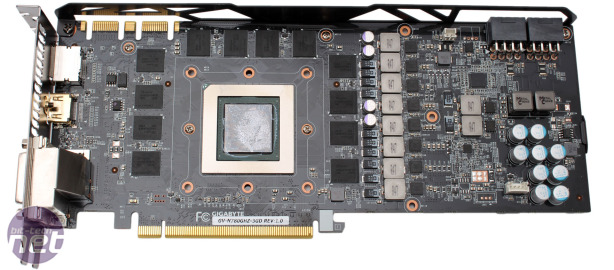Gigabyte GeForce GTX 780 GHz Edition 3GB Review
Manufacturer: GigabyteUK price (as reviewed): £384.38 (inc VAT)
US price (as reviewed): $519.99 (ex Tax)
We've looked at a fair number of custom made high end GPUs recently, and the latest one to enter our labs is the Gigabyte GTX 780 GHz Edition. With modifications to the clock speeds, power circuitry and cooling equipment there's plenty to get our teeth into. It comes in at £385, which is around £25 more than stock cards but still slightly less than basic AMD R9 290X cards.
The GTX 780 uses a cut down GK110 GPU with a total of 2,304 stream processors and 194 texture units. It has the full 384-bit wide memory interface and 48 ROPs of the GTX 780 Ti and Titan Black, however, as well as 3GB of GDDR5.
As Gigabyte's naming scheme hints at, its overclocked card is very fast by straight out of the box. It ships with a base core clock of 1,020MHz, a massive 18 percent faster than the default 863MHz. This also gives it a rated boost clock of 1,072MHz, though our sample stayed at a mighty 1,176MHz under load. This overclock is very impressive, as it's almost the same as that which we achieved with our stock GTX 780, indicating that Gigabyte has selected only the best GTX 780 GPUs for use in this card. Sadly, it hasn't overclocked the memory, which remains at 1.5GHz (6GHz effective). This is a shame as with our original GTX 780 we were able to raise this all the way to 7GHz.
Physically, the GTX 780 GHz Edition is 287mm long (20mm longer than stock) but crucially won't occupy more than two expansion slots, unlike the Sapphire R9 290X Tri-X. It maintains the standard video outputs, with the DisplayPort connection ensuring G-Sync compatibility. Along the top the usual pair of SLI connectors are present, but Gigabyte has beefed up the power connectivity, going from an 8-pin/6-pin combination to dual 8-pin connections to provide a little more juice – a 600W power supply is recommend as a minimum. Finally, on the back is a brushed metal backplate, and as with the Asus R9 290 DirectCU II, this is primarily for stability and aesthetic purposes.
While the backplate isn't used to cool the card, there's plenty of cooling going on at the front. The custom Windforce 3X cooler is rather hefty and responsible for the card's extra length. There's also an extended section at the top featuring the Windforce logo which increases the height of the card by 21mm beyond the edge of the PCI bracket. The open black shroud means that heat is dumped into your chassis from the three slimline 80mm fans, which are powered and controlled by a single header on the PCB.
Removing the cooler reveals a copper baseplate for the GPU connected to six copper heat pipes (two 8mm, four 6mm) in the main heatsink. One of these heat pipes loops back into the heatsink while the remaining five feed the secondary one. Aluminium plates and thermal pads are used to cool all twelve memory chips as well as the MOSFETs of the eight GPU power phases.
Looking at the PCB, we see Gigabyte has stuck with the SK Hynix H5GQ2H24AFR-R0C memory chips, which are rated for 6Gbps. The GTX 780 usually has a 6+2 phase arrangement, but Gigabyte has given the GPU two extra phases for a total of 8+2 power phases making for a supposedly cleaner supply of power to the GPU.
Unfortunately, we no longer have samples of the PNY GTX 780 XLR8 OC or Asus ROG Poseidon GTX 780 with which we can compare this card. However, we do still have up to date results for the Sapphire R9 290X Tri-X, which is similar in being a high-end custom cooled card.
Specifications
- Graphics processor Nvidia GeForce GTX 780, 1,020MHz (boosting to 1,072MHz)
- Pipeline 2,304 stream processors, 194 texture units, 48 ROPs
- Memory 3GB GDDR5, 6GHz effective
- Bandwidth 288.4GB/sec, 384-bit interface
- Compatibility DirectX 11, OpenGL 4.3
- Outputs/Inputs Dual Link DVI-D, Dual Link DVI-I, HDMI, DisplayPort
- Power connections 2 x 8-pin PCI-E top-mounted
- Size 287mm long, dual-slot
- Warranty Retailer dependent

MSI MPG Velox 100R Chassis Review
October 14 2021 | 15:04













Want to comment? Please log in.